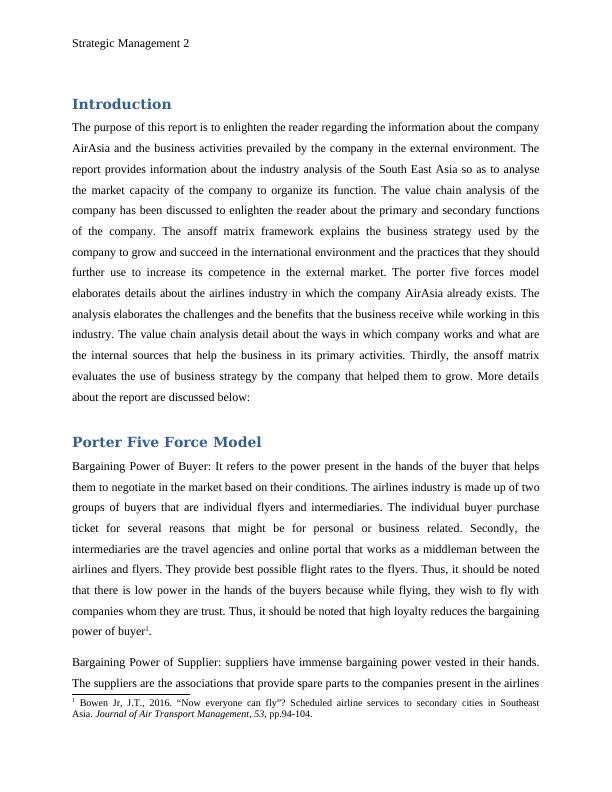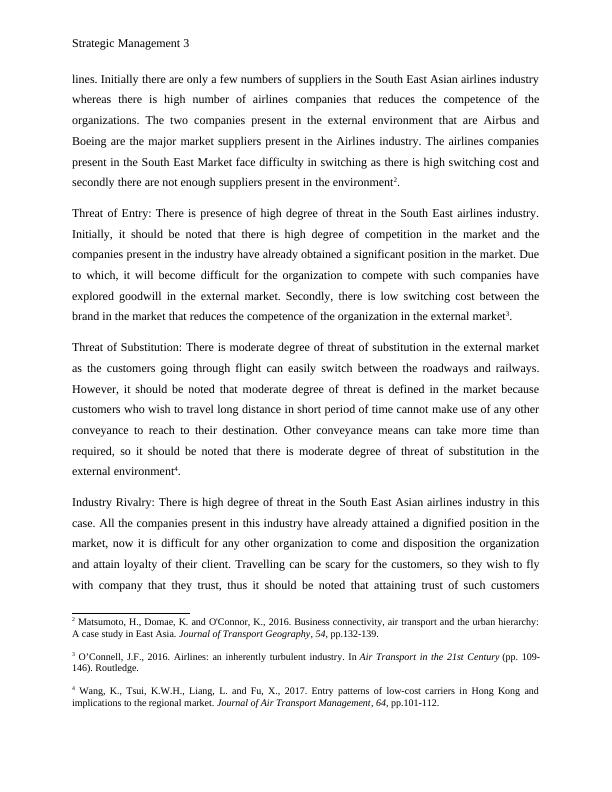Strategic Management of AirAsia: Industry Analysis, Value Chain Analysis, Ansoff Matrix
Added on 2022-10-12
11 Pages2896 Words344 Views
Running Head: Strategic Management
Strategic
Management
[Type the document subtitle]
Laptop04011
[Pick the date]
Strategic
Management
[Type the document subtitle]
Laptop04011
[Pick the date]

Strategic Management 1
Contents
Introduction......................................................................................................................................2
Porter Five Force Model..................................................................................................................2
Value Chain Analysis......................................................................................................................4
Ansoff Matrix..................................................................................................................................7
Bibliography....................................................................................................................................9
Contents
Introduction......................................................................................................................................2
Porter Five Force Model..................................................................................................................2
Value Chain Analysis......................................................................................................................4
Ansoff Matrix..................................................................................................................................7
Bibliography....................................................................................................................................9

Strategic Management 2
Introduction
The purpose of this report is to enlighten the reader regarding the information about the company
AirAsia and the business activities prevailed by the company in the external environment. The
report provides information about the industry analysis of the South East Asia so as to analyse
the market capacity of the company to organize its function. The value chain analysis of the
company has been discussed to enlighten the reader about the primary and secondary functions
of the company. The ansoff matrix framework explains the business strategy used by the
company to grow and succeed in the international environment and the practices that they should
further use to increase its competence in the external market. The porter five forces model
elaborates details about the airlines industry in which the company AirAsia already exists. The
analysis elaborates the challenges and the benefits that the business receive while working in this
industry. The value chain analysis detail about the ways in which company works and what are
the internal sources that help the business in its primary activities. Thirdly, the ansoff matrix
evaluates the use of business strategy by the company that helped them to grow. More details
about the report are discussed below:
Porter Five Force Model
Bargaining Power of Buyer: It refers to the power present in the hands of the buyer that helps
them to negotiate in the market based on their conditions. The airlines industry is made up of two
groups of buyers that are individual flyers and intermediaries. The individual buyer purchase
ticket for several reasons that might be for personal or business related. Secondly, the
intermediaries are the travel agencies and online portal that works as a middleman between the
airlines and flyers. They provide best possible flight rates to the flyers. Thus, it should be noted
that there is low power in the hands of the buyers because while flying, they wish to fly with
companies whom they are trust. Thus, it should be noted that high loyalty reduces the bargaining
power of buyer1.
Bargaining Power of Supplier: suppliers have immense bargaining power vested in their hands.
The suppliers are the associations that provide spare parts to the companies present in the airlines
1 Bowen Jr, J.T., 2016. “Now everyone can fly”? Scheduled airline services to secondary cities in Southeast
Asia. Journal of Air Transport Management, 53, pp.94-104.
Introduction
The purpose of this report is to enlighten the reader regarding the information about the company
AirAsia and the business activities prevailed by the company in the external environment. The
report provides information about the industry analysis of the South East Asia so as to analyse
the market capacity of the company to organize its function. The value chain analysis of the
company has been discussed to enlighten the reader about the primary and secondary functions
of the company. The ansoff matrix framework explains the business strategy used by the
company to grow and succeed in the international environment and the practices that they should
further use to increase its competence in the external market. The porter five forces model
elaborates details about the airlines industry in which the company AirAsia already exists. The
analysis elaborates the challenges and the benefits that the business receive while working in this
industry. The value chain analysis detail about the ways in which company works and what are
the internal sources that help the business in its primary activities. Thirdly, the ansoff matrix
evaluates the use of business strategy by the company that helped them to grow. More details
about the report are discussed below:
Porter Five Force Model
Bargaining Power of Buyer: It refers to the power present in the hands of the buyer that helps
them to negotiate in the market based on their conditions. The airlines industry is made up of two
groups of buyers that are individual flyers and intermediaries. The individual buyer purchase
ticket for several reasons that might be for personal or business related. Secondly, the
intermediaries are the travel agencies and online portal that works as a middleman between the
airlines and flyers. They provide best possible flight rates to the flyers. Thus, it should be noted
that there is low power in the hands of the buyers because while flying, they wish to fly with
companies whom they are trust. Thus, it should be noted that high loyalty reduces the bargaining
power of buyer1.
Bargaining Power of Supplier: suppliers have immense bargaining power vested in their hands.
The suppliers are the associations that provide spare parts to the companies present in the airlines
1 Bowen Jr, J.T., 2016. “Now everyone can fly”? Scheduled airline services to secondary cities in Southeast
Asia. Journal of Air Transport Management, 53, pp.94-104.

Strategic Management 3
lines. Initially there are only a few numbers of suppliers in the South East Asian airlines industry
whereas there is high number of airlines companies that reduces the competence of the
organizations. The two companies present in the external environment that are Airbus and
Boeing are the major market suppliers present in the Airlines industry. The airlines companies
present in the South East Market face difficulty in switching as there is high switching cost and
secondly there are not enough suppliers present in the environment2.
Threat of Entry: There is presence of high degree of threat in the South East airlines industry.
Initially, it should be noted that there is high degree of competition in the market and the
companies present in the industry have already obtained a significant position in the market. Due
to which, it will become difficult for the organization to compete with such companies have
explored goodwill in the external market. Secondly, there is low switching cost between the
brand in the market that reduces the competence of the organization in the external market3.
Threat of Substitution: There is moderate degree of threat of substitution in the external market
as the customers going through flight can easily switch between the roadways and railways.
However, it should be noted that moderate degree of threat is defined in the market because
customers who wish to travel long distance in short period of time cannot make use of any other
conveyance to reach to their destination. Other conveyance means can take more time than
required, so it should be noted that there is moderate degree of threat of substitution in the
external environment4.
Industry Rivalry: There is high degree of threat in the South East Asian airlines industry in this
case. All the companies present in this industry have already attained a dignified position in the
market, now it is difficult for any other organization to come and disposition the organization
and attain loyalty of their client. Travelling can be scary for the customers, so they wish to fly
with company that they trust, thus it should be noted that attaining trust of such customers
2 Matsumoto, H., Domae, K. and O'Connor, K., 2016. Business connectivity, air transport and the urban hierarchy:
A case study in East Asia. Journal of Transport Geography, 54, pp.132-139.
3 O’Connell, J.F., 2016. Airlines: an inherently turbulent industry. In Air Transport in the 21st Century (pp. 109-
146). Routledge.
4 Wang, K., Tsui, K.W.H., Liang, L. and Fu, X., 2017. Entry patterns of low-cost carriers in Hong Kong and
implications to the regional market. Journal of Air Transport Management, 64, pp.101-112.
lines. Initially there are only a few numbers of suppliers in the South East Asian airlines industry
whereas there is high number of airlines companies that reduces the competence of the
organizations. The two companies present in the external environment that are Airbus and
Boeing are the major market suppliers present in the Airlines industry. The airlines companies
present in the South East Market face difficulty in switching as there is high switching cost and
secondly there are not enough suppliers present in the environment2.
Threat of Entry: There is presence of high degree of threat in the South East airlines industry.
Initially, it should be noted that there is high degree of competition in the market and the
companies present in the industry have already obtained a significant position in the market. Due
to which, it will become difficult for the organization to compete with such companies have
explored goodwill in the external market. Secondly, there is low switching cost between the
brand in the market that reduces the competence of the organization in the external market3.
Threat of Substitution: There is moderate degree of threat of substitution in the external market
as the customers going through flight can easily switch between the roadways and railways.
However, it should be noted that moderate degree of threat is defined in the market because
customers who wish to travel long distance in short period of time cannot make use of any other
conveyance to reach to their destination. Other conveyance means can take more time than
required, so it should be noted that there is moderate degree of threat of substitution in the
external environment4.
Industry Rivalry: There is high degree of threat in the South East Asian airlines industry in this
case. All the companies present in this industry have already attained a dignified position in the
market, now it is difficult for any other organization to come and disposition the organization
and attain loyalty of their client. Travelling can be scary for the customers, so they wish to fly
with company that they trust, thus it should be noted that attaining trust of such customers
2 Matsumoto, H., Domae, K. and O'Connor, K., 2016. Business connectivity, air transport and the urban hierarchy:
A case study in East Asia. Journal of Transport Geography, 54, pp.132-139.
3 O’Connell, J.F., 2016. Airlines: an inherently turbulent industry. In Air Transport in the 21st Century (pp. 109-
146). Routledge.
4 Wang, K., Tsui, K.W.H., Liang, L. and Fu, X., 2017. Entry patterns of low-cost carriers in Hong Kong and
implications to the regional market. Journal of Air Transport Management, 64, pp.101-112.

End of preview
Want to access all the pages? Upload your documents or become a member.
Related Documents
AirAsia and Tune Group: Strategic Management Analysislg...
|12
|2866
|239
Strategic Management - Analysis of Airasia Airlines and Tune Grouplg...
|10
|2031
|343
Strategy and Case Analysis Assignment - DOClg...
|14
|3529
|258
Business Analysis and Valuationlg...
|16
|1291
|35
Porter's Five Forces Model Analysis of US Airline Industrylg...
|7
|1602
|336
Business Strategy of Qantas: Analysis and Recommendationslg...
|12
|4140
|427